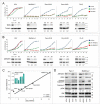Co-dependency between KRAS addiction and ARHGEF2 promotes an adaptive escape from MAPK pathway inhibition
- PMID: 28656876
- PMCID: PMC6748365
- DOI: 10.1080/21541248.2017.1337545
Co-dependency between KRAS addiction and ARHGEF2 promotes an adaptive escape from MAPK pathway inhibition
Abstract
Oncogenic KRAS engages multiple effector pathways including the MAPK cascade to promote proliferation and survival of pancreatic cancer cells. KRAS-transformed cancer cells exhibit oncogene addiction to sustained activity of RAS for maintenance of malignant phenotypes. Previously, we have shown an essential role for the RHO guanine exchange factor ARHGEF2 for growth and survival of RAS-transformed pancreatic tumors. Here, we have determined that pancreatic cancer cells demonstrating KRAS addiction are significantly dependent on expression of ARHGEF2. Furthermore, enforced expression of ARHGEF2 desensitizes cells to pharmacological MEK inhibition and initiates a positive feedback loop which activates ERK phosphorylation and the downstream ARHGEF2 promoter. Therefore, targeting ARHGEF2 expression may increase the efficacy of MAPK inhibitors for treatment of RAS-dependent pancreatic cancers.
Keywords: ARHGEF2; GEF-H1; KRAS; MEK inhibition; Ras dependency; oncogene addiction; pancreatic cancer.
Figures


Similar articles
-
Dynamic Coupling of MAPK Signaling to the Guanine Nucleotide Exchange Factor GEF-H1.Onco Targets Ther. 2025 Jan 25;18:147-159. doi: 10.2147/OTT.S496228. eCollection 2025. Onco Targets Ther. 2025. PMID: 39882405 Free PMC article. Review.
-
An oncogenic KRAS transcription program activates the RHOGEF ARHGEF2 to mediate transformed phenotypes in pancreatic cancer.Oncotarget. 2017 Jan 17;8(3):4484-4500. doi: 10.18632/oncotarget.13152. Oncotarget. 2017. PMID: 27835861 Free PMC article.
-
The RhoGEF GEF-H1 is required for oncogenic RAS signaling via KSR-1.Cancer Cell. 2014 Feb 10;25(2):181-95. doi: 10.1016/j.ccr.2014.01.025. Cancer Cell. 2014. PMID: 24525234
-
Epidermal Growth Factor Receptor Signaling to the Mitogen Activated Protein Kinase Pathway Bypasses Ras in Pancreatic Cancer Cells.Pancreas. 2016 Feb;45(2):286-92. doi: 10.1097/MPA.0000000000000379. Pancreas. 2016. PMID: 26262587 Free PMC article.
-
Targeting KRAS for diagnosis, prognosis, and treatment of pancreatic cancer: Hopes and realities.Eur J Cancer. 2016 Feb;54:75-83. doi: 10.1016/j.ejca.2015.11.012. Epub 2015 Dec 28. Eur J Cancer. 2016. PMID: 26735353 Review.
Cited by
-
Regulation and functions of the RhoA regulatory guanine nucleotide exchange factor GEF-H1.Small GTPases. 2021 Sep-Nov;12(5-6):358-371. doi: 10.1080/21541248.2020.1840889. Epub 2020 Oct 30. Small GTPases. 2021. PMID: 33126816 Free PMC article. Review.
-
Androgen deprivation restores ARHGEF2 to promote neuroendocrine differentiation of prostate cancer.Cell Death Dis. 2022 Nov 5;13(11):927. doi: 10.1038/s41419-022-05366-8. Cell Death Dis. 2022. PMID: 36335093 Free PMC article.
-
Dynamic Coupling of MAPK Signaling to the Guanine Nucleotide Exchange Factor GEF-H1.Onco Targets Ther. 2025 Jan 25;18:147-159. doi: 10.2147/OTT.S496228. eCollection 2025. Onco Targets Ther. 2025. PMID: 39882405 Free PMC article. Review.
-
The Crossroads between RAS and RHO Signaling Pathways in Cellular Transformation, Motility and Contraction.Genes (Basel). 2021 May 27;12(6):819. doi: 10.3390/genes12060819. Genes (Basel). 2021. PMID: 34071831 Free PMC article. Review.
-
High ARHGEF2 (GEF-H1) Expression is Associated with Poor Prognosis Via Cell Cycle Regulation in Patients with Pancreatic Cancer.Ann Surg Oncol. 2021 Aug;28(8):4733-4743. doi: 10.1245/s10434-020-09383-9. Epub 2021 Jan 3. Ann Surg Oncol. 2021. PMID: 33393038
References
-
- Almoguera C, Shibata D, Forrester K, Martin J, Arnheim N, Perucho M. Most human carcinomas of the exocrine pancreas contain mutant c-K-ras genes. Cell 1988; 53:549-54; PMID:2453289; https://doi.org/10.1016/0092-8674(88)90571-5 - DOI - PubMed
-
- Ardito CM, Gruner BM, Takeuchi KK, Lubeseder-Martellato C, Teichmann N, Mazur PK, Delgiorno KE, Carpenter ES, Halbrook CJ, Hall JC, et al.. EGF receptor is required for KRAS-induced pancreatic tumorigenesis. Cancer Cell 2012; 22:304-17; PMID:22975374; https://doi.org/10.1016/j.ccr.2012.07.024 - DOI - PMC - PubMed
-
- Brecht M, Steenvoorden AC, Collard JG, Luf S, Erz D, Bartram CR, Janssen JW. Activation of gef-h1, a guanine nucleotide exchange factor for RhoA, by DNA transfection. Int J Cancer 2005; 113:533-40; PMID:15455375; https://doi.org/10.1002/ijc.20626 - DOI - PubMed
-
- Brummelkamp TR, Bernards R, Agami R. Stable suppression of tumorigenicity by virus-mediated RNA interference. Cancer Cell 2002; 2:243-7; PMID:12242156; https://doi.org/10.1016/S1535-6108(02)00122-8 - DOI - PubMed
-
- Chen JC, Zhuang S, Nguyen TH, Boss GR, Pilz RB. Oncogenic Ras leads to Rho activation by activating the mitogen-activated protein kinase pathway and decreasing Rho-GTPase-activating protein activity. J Biol Chem 2003; 278:2807-18; PMID:12429740; https://doi.org/10.1074/jbc.M207943200 - DOI - PubMed
Publication types
MeSH terms
Substances
Grants and funding
LinkOut - more resources
Full Text Sources
Other Literature Sources
Miscellaneous
